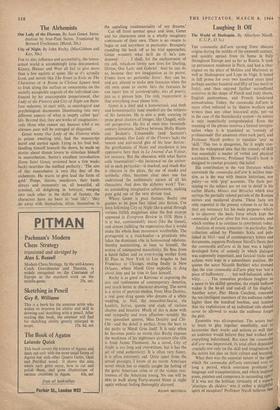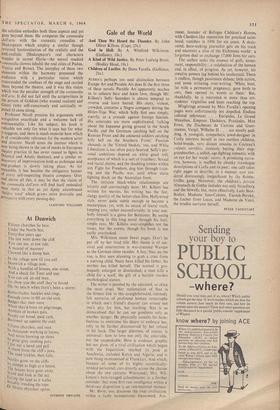Laughing It Off
The World of Harlequin. By Allardyce Nicoll. (C.U.P., £5 5s.) THE commedia dell'arte sprang from obscure origins during the middle of the sixteenth century, and quickly spread from its home in Italy throughout Europe and as far as Russia. It took up permanent residence in Paris, and had a clear impact on the plays of Moliere and Marivaux as well as Shakespeare and Lope de Vega. It lasted in full prime for over two hundred years (and perhaps another hundred and fifty of less merit in Italy), and then enjoyed further secondhand existence in the shape of Punch and Judy shows, English pantomimes, and French boulevard mimodramas. Today, the commedia dell'arte is more often referred to by theatre workers and writers than any other historical style, yet—as in the case of the Stanislavsky system—its nature is only imperfectly comprehended. Even the meaning of the phrase receives a limited interpre- tation when it is translated as `comedy of professionals' (for amateurs often took part), and Professor Nicoll prefers to translate 'arte' as 'skill.' This too is dangerous, for it might con- firm the widespread idea that the comedy of skill was essentially a matter of verbal and physical acrobatics. However, Professor Nicoll's book is designed to combat precisely this belief.
His contribution to the vast literature which surrounds the commedia dell'arte is neither mas- sive, as is the way with theatre historians, nor paltry—as with `pop' accounts. The facts per- taining to the subject are set out in detail in his :f earlier Masks, Mimes and Miracles which also surveys the partially related periods of the Roman mimes and mediwval drama. These facts are only repeated in the present volume in so far as they are necessary for his main purpose—which is to discover the basic force which kept the commedia dell'arte alive for two centuries, and which enables it to continue to reverberate today.
Analysis of extant scenarios—in particular, the collection edited by Flaminio Scala and pub- lished in 1611—and of contemporary letters and documents, supports Professor Nicoll's thesis that the commedia dell'arte at its best was a highly developed form of comedy in which dialogue was supremely important, and farcical tricks and actions were kept in a subordinate position. He quotes the actor Niccolb Barbieri who stressed that the true commedia dell'arte play was `not a piece of buffoonery. . . but well-balanced, sober, witty. . . . The comedian produces laughter as a sauce to his skilful speeches; the stupid buffoon makes it the be-all and end-all of his display.' Another actor, Pier Maria Cecchini, esteemed the ten intelligent members of the audience rather higher than the hundred boobies, and insisted that the exploitation of an individual role should never be allowed to make the audience forget the plot.
Ensemble was all-important. The actors had to learn to play together unselfishly, and to harmonise their words and actions so well that an audience would believe they had worked out everything beforehand. But since the commedia dell'arte was improvised, its total effect depended crucially not only on the skill and imagination Of the actors but also on their culture and learning.
What then was the essential nature of the Well which the commedia dell'arte exercised over so long a period, which overcame problems of language and transplantation, and which inspired poets, painters and composers in succeeding ages? If it was not the brilliant virtuosity of a superb 'plastique du thedtre,' was it rather a delightful spirit of escapism? Professor Nicoll believes that
the solution embodies both these aspects and yet goes beyond them. He compares the comtnedia dell'arte with the romantic comedies of Shakespeare which employ a similar though reversed harmonisation of the realistic and the anti-realistic (Shakespeare's real characters wander in unreal Illyria—the unreal masked corm:edict clowns inhabit the real cities of Padua, Venice and Rome). The interplay of these two elements within the harmony presented the audience with a particular vision which transcended the confines of the stage and carried them beyond the theatre, and it was this vision Which was the peculiar strength of the commedia dell'arte. It did not fail until the scriptwriters in the person of Goldoni (who wanted realism) and Gozzi (who self-consciously and satirically re- jected it) came along.
Professor Nicoll presents his arguments with scrupulous exactitude and a welcome lack of sentimentality. Like his subject, his book is yaluable not only for what it says but for what it suggests, and there is much material here which is of considerable relevance for the modern actor and director. Nicoll notes the interest which is now being shown in the use of masks in European theatre practice (it has never ceased to figure in Oriental and Asiatic theatres), and a similar re- discovery of improvisation both as technique and end-product is slowly taking place. As for ensemble, it has become the obligatory banner Of every self-respecting theatre company. Over and above all this, it may be that the vision of the commedia dell'arte will find itself embodied ' ?nce more in that as yet dkmly adumbrated theatre total which grows more desirable and Persuasive with every passing day.
CLIFFORD WILLIAMS



































 Previous page
Previous page